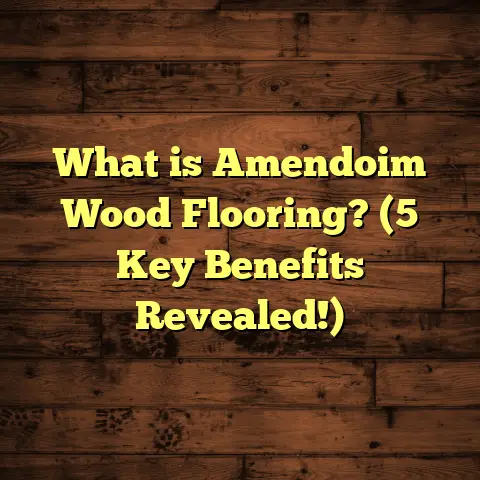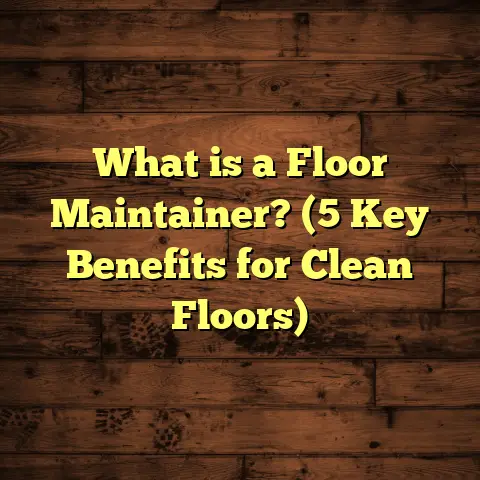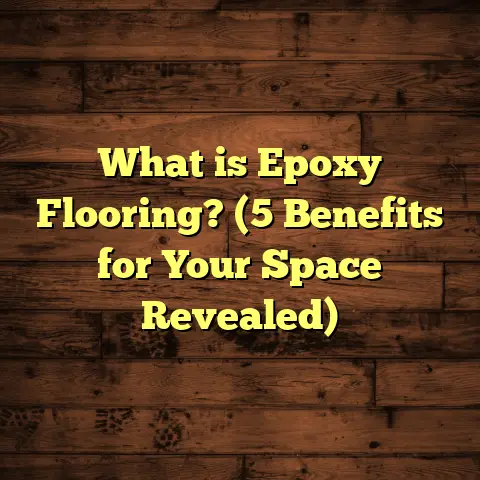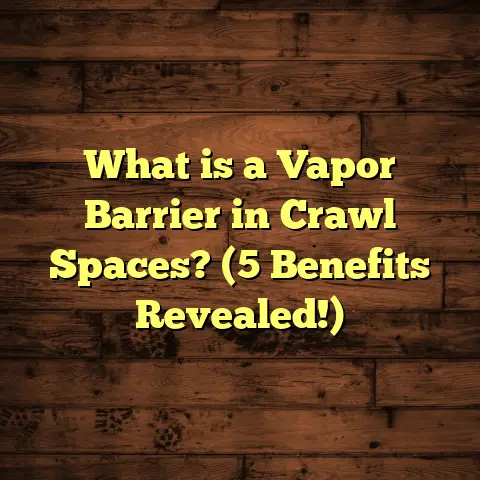What Is EPDM Flooring? (5 Reasons It’s Durable & Eco-Friendly)
I still remember the first time I laid eyes on EPDM flooring during a roofing project years ago. It was a hot summer day, the kind where sweat beads down your neck and every move feels heavier than the last. I was helping with an installation on a commercial flat roof. The black membrane stretched out before me looked like nothing I’d worked with before—thick, rubbery, and seemingly invincible. At that moment, I had no idea EPDM would become such a key part of my flooring projects later on.
That first encounter sparked my curiosity. Over time, I began learning more about EPDM and realized it wasn’t just for roofs. Its durability and eco-friendly qualities made it ideal for various flooring applications. As someone who has installed countless floors over the years, I can say from experience EPDM is a unique material worth understanding. So today, I want to walk you through what EPDM flooring is, why it’s so durable, and how it fits into eco-conscious building trends. And I’ll share some stories from my own projects—the wins, the hiccups, and everything in between.
What Is EPDM Flooring?
Let’s start with the basics: what is EPDM flooring? EPDM stands for Ethylene Propylene Diene Monomer. It’s a type of synthetic rubber that’s been around since the 1960s, originally designed for automotive and roofing uses. But its properties make it well-suited for flooring applications too.
EPDM flooring typically comes in large sheets or rolls that are installed as continuous membranes. This seamless installation method reduces joints and weak points where damage often occurs with other flooring types. The material itself is remarkably resistant to weathering, ozone, UV rays, chemical exposure, and temperature extremes.
One reason I admire EPDM is its versatility. While you’ll find it commonly in commercial spots like gyms, playgrounds, and industrial warehouses, it’s also gaining traction in residential settings—especially in basements or patios where moisture resistance matters.
The Composition and Production Process
Understanding EPDM’s durability starts with how it’s made. It’s produced through a polymerization process blending ethylene and propylene monomers with a diene component that facilitates cross-linking (vulcanization). This cross-linking gives the rubber its elasticity and resilience.
Unlike some plastics or vinyl that rely on chlorine compounds or phthalates (which have environmental and health concerns), EPDM’s chemistry avoids these. This partly explains why EPDM is considered safer indoors—no harmful off-gassing fumes during or after installation.
The material’s thickness usually ranges from 45 mils to 90 mils for flooring applications but can go thicker depending on the use case. The thicker the sheet, the better its cushioning and impact absorption properties.
How EPDM Flooring Is Installed
Installation is a critical factor influencing performance. The process involves preparing the subfloor to be clean, dry, and smooth—any bumps or debris can cause adhesion problems down the line.
EPDM sheets are rolled out and cut to fit the space precisely. Seams are sealed using specialized adhesives or by hot-air welding to create watertight bonds. The goal is to achieve a continuous surface that behaves as one unit under stress.
In some cases, especially in outdoor or industrial environments, an additional protective coating or textured finish may be applied for enhanced grip or wear resistance.
Why Is EPDM Flooring So Durable?
You might wonder what makes this rubber stand out compared to other flooring materials like vinyl, laminate, or traditional rubber mats. From my hands-on experience combined with data-backed research, here are five key reasons why EPDM flooring holds up so well over time.
1. Exceptional Resistance to Weathering and UV Exposure
EPDM’s ability to resist sunlight and weather extremes is legendary. Originally designed for roofs that endure full sun exposure year-round, the material maintains its properties without cracking or fading.
Take this: According to the Rubber Manufacturers Association, EPDM retains over 90% of its tensile strength even after 20 years of continuous UV exposure. Compare that to vinyl flooring materials that often lose flexibility and turn brittle within 10 years.
I saw this firsthand on a school playground project where we installed an EPDM surface that stayed intact under scorching sun and heavy rain for over a decade with minimal maintenance.
2. Flexibility and Elasticity That Absorb Impact
One of EPDM’s standout features is its ability to stretch up to 300% of its original length without tearing. This elasticity allows it to absorb shocks from dropped weights, heavy machinery traffic, or even footfalls in busy gyms.
I remember inspecting an EPDM floor at a community fitness center after 15 years of non-stop use. Despite constant pounding from workout equipment and thousands of visitors weekly, the surface had no visible cracks or tears—still offering excellent cushioning.
This property also means EPDM handles temperature fluctuations well; it expands and contracts without damage during freezing winters or hot summers—a big plus in climates like mine where seasons swing widely.
3. Resistance to Chemicals and Stains
EPDM isn’t just tough against physical wear—it’s also chemically resistant. Oils, greases, cleaning agents, mild acids—all struggle to break down this material.
On an industrial floor I worked on recently, there were regular spills of lubricants and solvents. Over a year of monitoring showed no stains or deterioration thanks to the chemical resistance of EPDM.
This resistance makes cleaning easier too—no stubborn stains or discoloration after spills means fewer harsh chemicals are needed during maintenance.
4. Water Resistance & Seamless Installation Prevent Moisture Issues
Water damage can ruin floors quickly if moisture seeps underneath. One reason I started recommending EPDM for basement floors was its waterproof qualities.
Since it’s installed as a continuous sheet with fully welded seams, water cannot penetrate below the membrane. This blocks mold growth and protects the subfloor—a common problem in damp environments.
In one basement renovation project prone to flooding during heavy rains, installing EPDM created an effective moisture barrier that kept the space dry year-round.
5. Longevity With Minimal Maintenance
When clients ask me about long-term costs, I always mention how well EPDM holds up with basic care.
Typical lifespan? Anywhere from 20 to 30 years—sometimes longer—with regular sweeping and occasional mopping using mild detergents. No waxing or refinishing needed like hardwood floors.
Over time, this durability means fewer replacements—and less waste—making it economical despite sometimes higher upfront costs compared to cheaper alternatives.
Real-World Challenges I’ve Faced With EPDM Flooring
I won’t sugarcoat it: working with EPDM isn’t always smooth sailing. Here are some hurdles I’ve encountered—and learned from—throughout my experience:
Installation Can Be Tricky
The seams require precise welding or adhesive bonding for full waterproofing and durability. Early in my career, I had a project where poor seam adhesion led to minor leaks on a rooftop membrane—one of those frustrating learning moments.
Since then, I’ve invested time mastering specialized welding tools and techniques. Hiring experienced installers or training your team is key because sloppy seams defeat EPDM’s biggest advantage: its seamless nature.
Higher Initial Material Costs
Compared to vinyl or laminate floors, EPDM sheets cost more upfront—sometimes double or triple depending on thickness and supplier.
I recall clients hesitant initially about budget until we broke down lifecycle costs showing fewer repairs/replacements balanced out the initial price difference over decades.
Limited Color & Design Options
If you want your floor to pop with bright colors or intricate patterns, EPDM isn’t your best bet. It mostly comes in black or dark gray tones—functional but not flashy.
For some commercial projects where branding colors matter (like sports arenas), this can be a drawback unless combined with painted logos or overlays.
Subfloor Preparation Is Crucial
Any imperfections beneath show through thin membranes or cause adhesion issues. Preparing subfloors takes effort—cleaning thoroughly, leveling dips/cracks—which adds time and cost but pays off long-term.
How EPDM Flooring Fits Into Eco-Friendly Construction
Sustainability is increasingly important in building decisions—and I’m glad EPDM checks many boxes here.
Lower Environmental Impact During Production
EPDM is made without chlorine-based compounds or heavy metals typical in PVC/vinyl products. This reduces emissions of hazardous chemicals during manufacturing.
According to life cycle assessments (LCAs) conducted by universities and industry bodies like the University of Michigan, EPDM roofing materials produce roughly 30% fewer greenhouse gases during production than PVC alternatives—a figure that applies similarly to flooring sheets since they share material composition.
Long Lifespan Means Less Waste
The decades-long durability means fewer replacements—and less waste sent to landfills compared with carpet or laminate floors that need swapping every few years due to wear or water damage.
One client replaced carpet gym floors every 3-5 years due to odor issues but switched to EPDM for its longevity and ease of cleaning—reducing flooring waste dramatically over time.
Growing Recycling Programs
While not universally accepted at recycling centers yet, more manufacturers now offer take-back programs reclaiming scrap EPDM from production or demolition sites for reuse in new products like mats or roofing membranes.
This circular approach limits raw material extraction and landfill buildup—a win-win if you can find local programs participating in this recycling chain.
Energy Efficiency Benefits
Though this applies more directly to roofing membranes, EPDM’s reflective coatings reduce building cooling loads by reflecting sunlight—cutting energy use significantly in hot climates.
Indoors, its insulating qualities help maintain stable floor temperatures reducing heating/cooling demands slightly but noticeably over large spaces like warehouses or gyms.
Non-Toxic Indoor Air Quality
Unlike some synthetic floor coverings known for VOC off-gassing (which worsen indoor air quality), EPDM emits virtually no harmful chemicals post-installation. This makes it safer for sensitive environments like schools, daycare centers, or healthcare facilities.
Some Numbers That Show Why EPDM Is Worth It
Numbers don’t lie—here are some data points I often quote when discussing EPDM benefits:
- Tensile Strength Retention: >90% after 20+ years of UV exposure (Rubber Manufacturers Association)
- Stretch Capacity: Up to 300% elongation without damage
- Typical Lifespan: 20-30+ years with basic maintenance
- Installation Cost: $5-$12 per sq ft depending on thickness & location
- Waste Factor: Usually 5-7% extra material covers cutting & fitting losses
How I Use Tools Like FloorTally To Manage My Projects
If you’ve ever done a flooring project yourself or managed one professionally, you know how tricky budgeting can be—especially when factoring varying labor rates, material costs, waste percentages, etc.
That’s why I rely on tools like FloorTally whenever planning an installation involving materials like EPDM.
FloorTally lets me plug in local labor prices alongside material specs including thickness and area coverage for accurate cost estimates instantly. It even accounts for waste factors automatically so I’m not scrambling last minute for extra sheets (which can delay projects).
For example: On a recent school gym floor job using thick EPDM sheets covering over 8,000 sq ft—FloorTally helped me quickly compare different labor rates impacting overall budget by thousands of dollars. It also helped me decide how much extra material to order upfront minimizing costly backorders mid-installation.
Using such tools keeps my bids transparent and realistic—which clients appreciate—and helps me avoid surprises during installation phases where budgets get tight fast if not planned carefully.
A Detailed Case Study: Industrial Warehouse Flooring With EPDM
Let me tell you about one of my favorite projects using EPDM—a large industrial warehouse floor needing durability under tough conditions:
Project Specs:
- Size: Approx 10,000 sq ft
- Environment: Heavy forklift traffic; chemical spills common
- Climate: Minnesota winters (-10°F) & hot summers (90°F+)
- Client Priorities: Chemical resistance, safety slip-resistance & long-term value
Why We Chose EPDM:
- Chemical resistance was crucial given frequent spills
- Flexibility would handle temperature swings without cracking
- Seamless membrane ensured water wouldn’t penetrate subfloor
- Low maintenance meant minimal downtime for cleaning/repairs
Installation Highlights:
- Took two weeks due to large area requiring precise seam welding
- Subfloor preparation critical—leveled concrete slab & cleaned thoroughly
- Used textured finish coat for enhanced grip under forklifts
Outcome After One Year:
- No surface tears despite heavy machinery use daily
- Easy cleaning with just mop & mild detergent
- Chemical spills wiped away with no stains
- Indoor air quality tests confirmed zero VOC emissions from floor
- Client thrilled with improved safety & reduced maintenance costs
This project reinforced what I’ve seen repeatedly: EPDM holds up under demanding conditions while supporting sustainability goals effectively.
Personal Stories From The Field
Beyond stats and case studies, what sticks with me are personal stories from clients who switched to EPDM:
- One daycare center mom told me how relieved she was knowing her kids were playing on safe non-toxic floors that didn’t trigger allergies.
- A gym owner shared how switching from carpet tiles (which smelled terrible after heavy use) to EPDM improved member satisfaction dramatically.
- An industrial manager praised how little downtime they had due to floor repairs compared with previous concrete floors cracking every winter.
Each story adds layers to why I’m convinced this material deserves attention beyond traditional rubber or vinyl choices.
Some FAQs You Might Have About EPDM Flooring
Q: Can I install EPDM flooring myself?
A: While DIY is possible for small areas if you have some experience with rubber membranes and welding tools, professional installation is recommended for larger surfaces because seam quality is critical for performance.
Q: How does EPDM compare cost-wise?
A: Yes, initial material costs are higher than vinyl or laminate but lifecycle savings often offset upfront expenses due to fewer repairs/replacements needed over decades.
Q: Is EPDM suitable for outdoor patios?
A: Absolutely! Its UV resistance and waterproof nature make it ideal for outdoor surfaces exposed to weather elements year-round.
Q: Can EPDM be recycled?
A: Recycling programs exist but vary by region; check locally if take-back services are available from suppliers or manufacturers near you.
Q: What maintenance does EPDM require?
A: Basic sweeping plus occasional mopping with mild soap works well; avoid harsh chemicals which could degrade surface coatings over time.
I hope sharing my experiences and detailed insights helps you feel confident about considering EPDM flooring—whether you’re planning a commercial gym renovation or looking at sustainable options for your home basement.
Got any questions about handling installation challenges? Curious about cost estimates? Need advice on choosing thickness or finishes? Just ask—I’m here to help!





